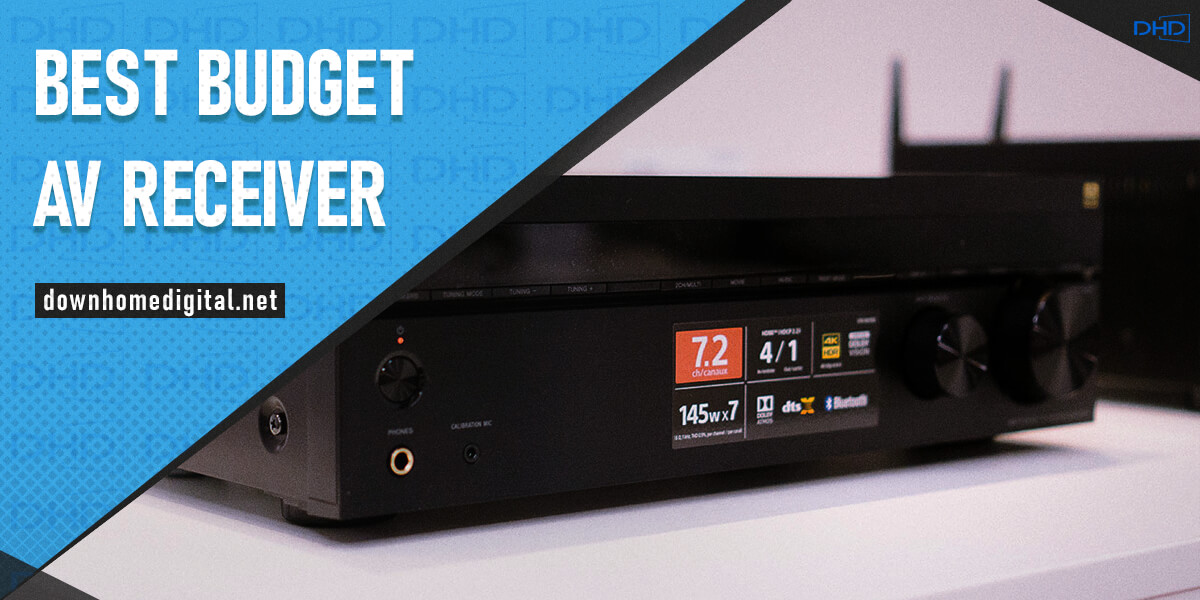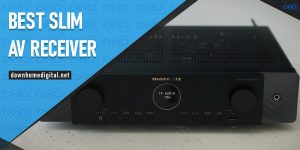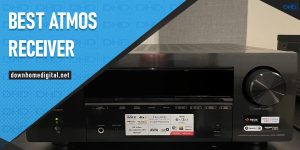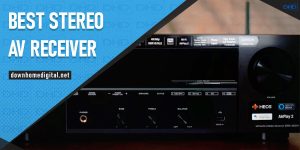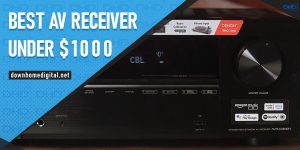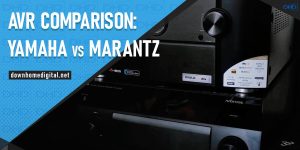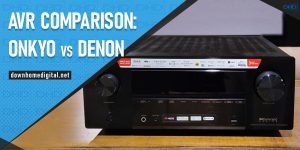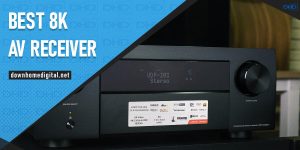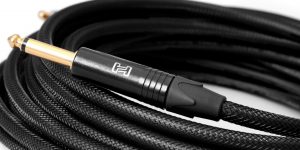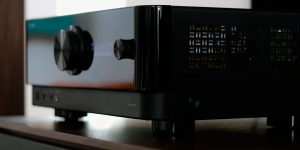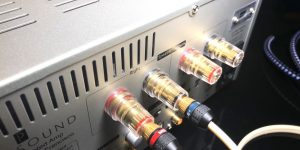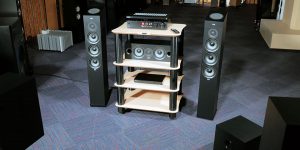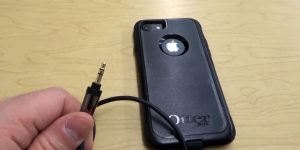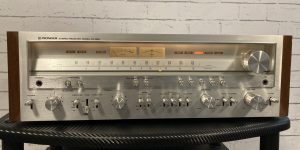Do you feel like upgrading your current home theater system to get that cinema-like experience without leaving your home? Many people buy an AV receiver, which is a smart thing to do. While manufacturers produce numerous high-end devices with a plethora of bells and whistles, I decided to focus on more affordable options to help buyers choose the best budget AV receiver. Such a device can unite all your video and audio sources into one central hub without making you bankrupt.
So, what capabilities can such inexpensive AV receivers add to your speakers? In what way do they affect the quality of the sound? I have delved into the world of such equipment, defined the features that differentiate long-lasting receivers from poor-quality devices, and shared recommendations on choosing a decent yet budget AVR.

Budget home theater receivers comparison table
| Name | Channels | Power output | HDMI in/out | Bluetooth/Wi-Fi | Review |
|---|---|---|---|---|---|
| Sony STR-DH790 best overall (with Dolby Atmos) | 7.2 | 145W/6 Ohm | 4/1 | yes/no | Review |
| Yamaha RX-V385 under $300 | 5.1 | 70W/8 Ohm | 4/1 | yes/no | Review |
| Denon AVR-S570BT also great | 5.2 | 70W/8 Ohm, 90W/6 Ohm | 4/1 | yes/no | Review |
What I paid attention to when picked budget AV receivers
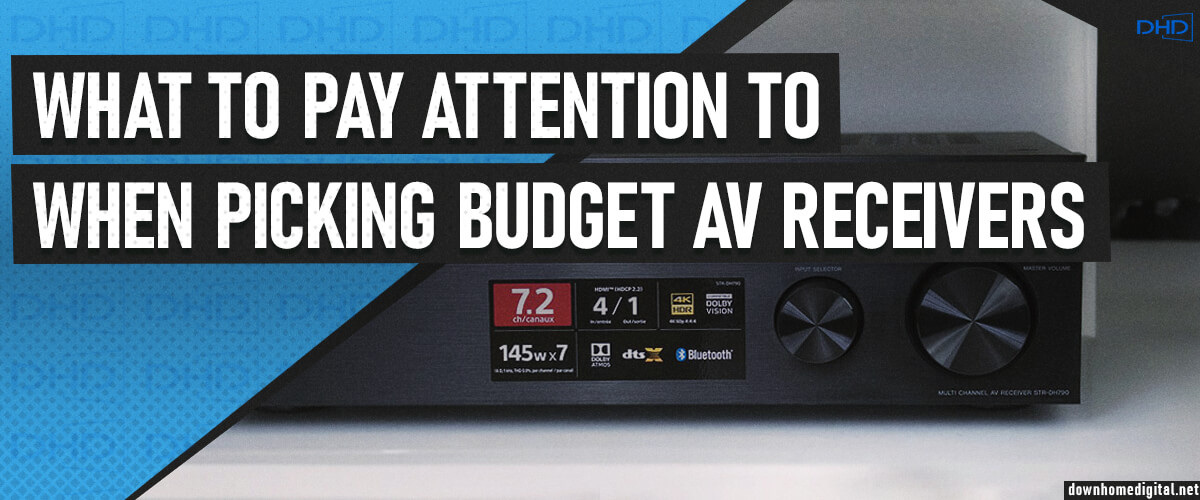
When I got down to selecting devices for my test, I was bewildered by how extensive the niche of entry-level AV receivers is. There are so many options that inexperienced users can easily get lost. To write an in-depth review, I defined the most important criteria. You can see them below.
Receiver power
Things here can get confusing because the info specified on the box rarely coincides with reality. Undoubtedly, you want a powerful receiver that can bring your speakers to the notch, but you must be very attentive. Some time ago, I bumped into an excellent receiver, and the manufacturer promised that this unit outputs 200 watts per channel. That was amazing, and I was about to buy it, but then I had a closer look at the specs. It was written in fine print that such power value was possible only if you connect a single receiver to it and play slow melodies in a quiet environment. That seemed like a total disappointment but became a great experience.
Don’t get too carried away with this parameter. I highly recommend being skeptical about declared power outputs. For example, if you see an AV receiver for music that boasts 125W/channel, divide that by two, and you’ll get an actual figure in case you plan to connect a pair of speakers and feed fully-frequency signals.
A good rule of thumb is to define the amount of required power by measuring your room and learning the characteristics of your speakers. These are two key factors that determine how powerful a receiver you should invest in. And remember, a medium-powered device that is properly tuned and with the right equipment can sound great.
Amplifier channels
A decent AV receiver offers at least a standard 5.1 surround sound setup. In this case, you get enough channels for connecting center, left-front, right-front, left-surround, and right-surround speakers, and one woofer. Of course, by adding this receiver to your home theater system, you will get a significantly fuller sound.
If you strive to create a fully immersive environment to enjoy every tone shift, you need an AV receiver with Dolby Atmos. In this case, we are talking about a 7.1-channel unit as the minimum. It allows attaching 2 more rear speakers that bring a perceptible upgrade to your system.
Most affordable AV receivers in my review are 5.2-channel receivers that perfectly cope with typical tasks you throw at them. I also selected one 7.2-channel receiver (Sony STR-DH790) for those users who aim at mimicking the feel you get while visiting a full-featured cinema. Of course, this receiver sounds better than other models, but its competitors also have something to offer their future owners.
Things are pretty straightforward when it comes to the number of channels. The more you get, the deeper and more powerful sound you’ll hear, thanks to more speakers scattered across the place. However, it should be remembered that there’s no sense for you to mindlessly chase a large number of channels of amplification. It will not be reasonable for all tasks. For most ordinary users, 5 or 7 channels will be enough, but if your demands are higher and you have enough money, then of course, you can look for models with 9 channels and more.
HDMI and other connections
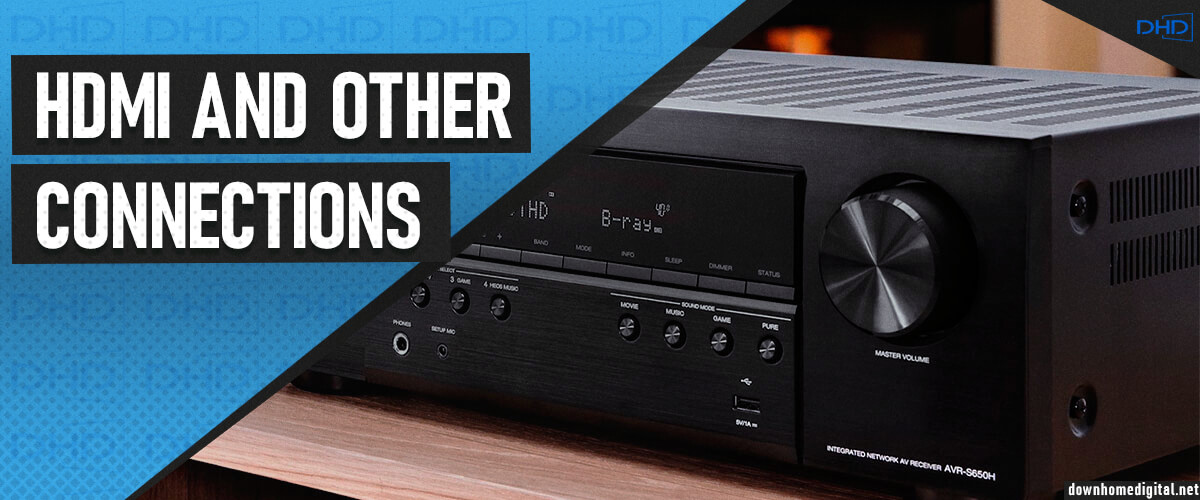
Of course, a qualitative budget AV receiver with HDMI inputs can easily handle audio and video signals that come from different connected devices. While pondering on how many HDMI ports you need, consider what equipment you are going to pair it with. This can be a TV, a CD player, a turntable, a media streamer, a Blu-ray player, PlayStation, and Xbox. However, the list can be longer. Of course, having one spare connector is an excellent future-proofing move. Keep in mind the HDMI standards. The most current HDMI standard today is 2.1. This version is called Ultra High Speed and can transmit a video stream in 8K and 10K resolution. But these are just the basic features; if you dig deeper, you’ll find many more interesting innovations.
If you are mainly interested in transmitting an audio signal, make sure your receiver is fitted with the appropriate input. RCA (red & white) and optical ports are the most common options. The latter implies using optical cables that convert an audio signal into pulses of light and deliver it to a receiver. Optical cables stay on par with HDMI inputs in terms of sound quality, and they seriously surpass RCA cables in this regard. Just make sure these cables aren’t tangled; otherwise, the light path will be blocked. Optical cables are unmatched if you need to transmit a signal over long distances because they don’t suffer from electromagnetic or radio frequency interference.
Another reliable alternative is coaxial cables, but they aren’t as popular as RCA and optical counterparts. Anyway, such cables brag about simplicity in use and a long service life thanks to the durable construction. Moreover, they are suitable for transferring medium-capacity data.
RCA cables are easy to recognize. These are red and white wires that transmit an audio signal without degrading its quality. You will likely use RCA cables if you want to connect a record player.
Another handy port is AUX input. Actually, it is a must if you need to connect a smartphone or a table, which is a frequent thing nowadays. AUX inputs are identical to 3.5mm ports on gadgets, and they come to the rescue when a wireless connection isn’t an option.
Built-in Wi-Fi, Bluetooth, and streaming services
More and more users want to get a decent budget AV receiver with Bluetooth and Wi-Fi not to deal with cords while streaming content. Using Wi-Fi, you can instantly access streaming services, e.g., Spotify, Deezer, Tidal, and enjoy your favorite music in a high-quality. The finest thing about Wi-Fi-capable receivers is that they are supplied with dedicated apps, which you can install on your smartphone/tablet and perform basic manipulations in no time. Just ensure you have good Wi-Fi coverage across your house.
Another handy wireless technology is Bluetooth. You can use it to initiate music playback from any paired device. The only pitfall here is that Bluetooth works within a limited space, unlike Wi-Fi.
If you are a loyal user of Apple devices, you can take advantage of the company’s proprietary technology called AirPlay. The latest version is AirPlay2, and it allows enjoying your favorite music and controls the playback by dint of several touches. Can you ask more?
4K and HDR formats
Chances are high you want a device capable of outputting 4K and HDR resolutions. This is a necessity rather than a whim nowadays, and there are solid options with such capabilities even among low-priced receivers.
The variety of 4K content is rapidly growing, so make sure you’ll get the best cheap AV receiver with 4K support to savor such movies. The same applies to HDR technology (High Dynamic Range), as it makes a plain picture so spectacular.
Thanks to HDR, you see images with expanded contrast, rich colors, and accurate details. If your TV supports HDR, but a receiver doesn’t – such a combo is useless. There are 3 HDR types – HDR10/10+, DV (Dolby Vision), and HLG. The most popular variant is HDR10, and it is frequently used by media development giants (e.g., Netflix). Dolby Vision also guarantees top-notch picture quality. By getting a receiver with HDR support, you stay on the safe side as you’ll be able to watch content that will be released in the nearest future.
How I tested budget home theater receivers
Striving to be as unbiased as possible, I gave all receivers a hard test drive. To evaluate how precisely they define sound details during video streaming, I watched Star Wars: The Force Awakens.
Moreover, I listened to numerous tracks across multiple genres. I also checked different streaming services.
- Led Zeppelin – Ramble On – Spotify
- Jacky Terrasson – Reach – Tidal
- The Weeknd – The Hills – Deezer
- Bob Marley & The Wailers – Turn Your Lights Down Low – (CD player)
- Radiohead – The National Anthem – (CD player)
- Arctic Monkeys – Do I Wanna Know – (CD player)
- Mark Nauseef – With Space in Mind (CD player)
- Mahler – Symphony No.2 (CD player)
My toolbox consisted of the following equipment:
- CD player SACD 30n
- Blu-ray player Sony UBP-X700
- Speaker wire – AudioQuest Type-9
- Speakers for movie – Klipsch RP-8060FA
- Stereo speakers:
- Sony SSCS3
- Q Acoustics 3020i
- Polk Audio Monitor XT60
Best budget AV receiver reviews
Sony STR-DH790 – best overall receiver with Dolby Atmos

This receiver boasts not only plenty of features but also a very reasonable price. It is the only 7-channel receiver in my test, but I was doubtful about how well it is optimized to satisfy both movie lovers and audiophiles. Let’s deal with it more thoroughly.
As for design and construction quality, it is not the most reliable device in the world. However, regarding the rating of budget receivers, Sony STR-DH790 is inferior only to its main competitor, Denon AVR-S670H, which is more expensive, due to the use of more reliable external and internal components and materials. Personally, I feel nostalgic for the old equipment of the 90s; at that time, Sony was mega-popular because of the price/quality ratio. Basically, nothing has changed in their tech except that this approach to tech is hopelessly outdated. However, this fact is forgivable since the receiver was released in 2018. The knobs turn, and the buttons are pressed, but I prefer the remote control; everything is too simple.
The first praise-worthy feature is bi-amp, which means it is possible to get surround sound from a pair of rear/height speakers in Dolby Atmos and DTS: X format. I tested this feature, and everything worked just fine.
Keep in mind that it requires speakers with a nominal impedance of at least 6 ohms, considering the power output of 90W/6 Ohms. Anything lower fails to work properly. I’ve also noted that all channels except the front left and right use spring-loaded terminals rather than screw terminals, which drastically reduces the range of wires you can use for a connection. I was astonished by such a decision, but I believe it has a money-saving basis in it.
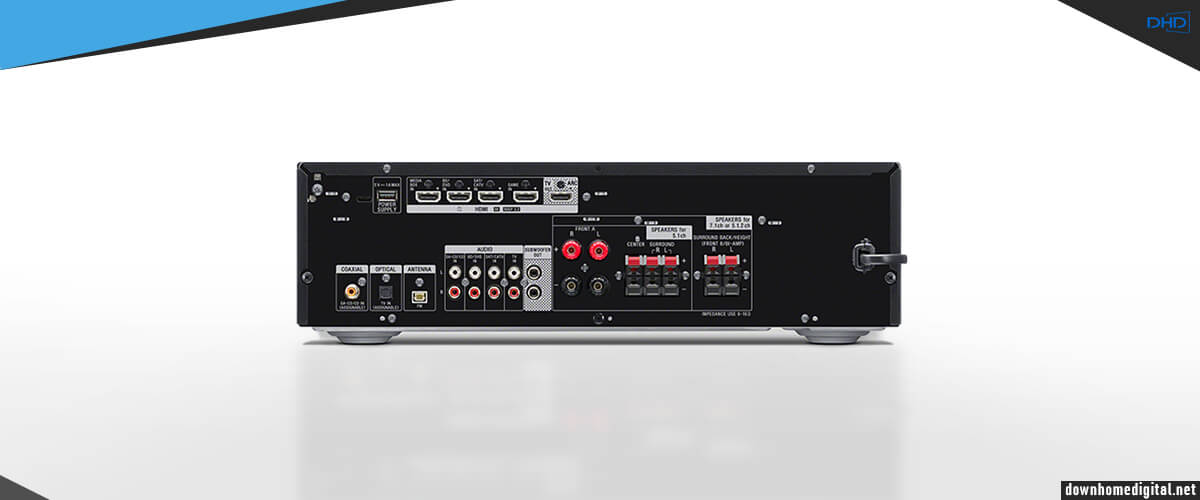
The lack of Wi-Fi was a disappointing surprise for me. However, there is Bluetooth, which saves the situation a bit.
When I first switched the receiver on, I saw a list of modes – “Watch”, “Listen”, “Easy Setup”, “Sound Effect”, and “Speaker Setting”. Menus are very intuitive, so getting the device ready for work is super easy. I activated auto-calibration. This is a remarkably handy feature, which determines the size of speakers and the distance to them from the listening position, sets their level, and adjusts an equalizer.
The lack of Wi-Fi was not a disappointing surprise for me, as it is normal for budget receivers. There is Bluetooth, and it should be noted that it copes with the task of streaming services very well. True, I had to leave my phone close to the receiver to get a stable signal. But let’s remember again that we are talking about an AVR released 5 years ago at the time of writing (2023). So I was quite satisfied with it, as I didn’t initially inflate my expectations. I switched between all available modes when listening to music, and the results were always very pleasant.

As for the surround sound quality, it’s simply amazing for such a cheap device, which surprised me a lot! I fully appreciated the beauty of the Atmos sound and the realism of the sound effects. To be frank, to the end, I will say that the overall soundstage of Sony STR-DH790 is a bit inferior to Denon AVR-S670H. But in general, the slightly chased sound of the model under review quite coped with movies in different genres, whether musical, action, or comedy.
I don’t often recommend speakers, but for this receiver, I’ve been testing a pair of Sony SSCS3 front speakers for the umpteenth time, and I find the combination just fine. Perhaps the brand has a secret because these rather bulky floorstanding things seem to unlock the receiver’s potential, and everything I listen to repeatedly sounds in new colors, adding details and nuances to tracks that are not heard with other speakers.
I’ve always been impressed by Sony products, but this time, I was pleasantly surprised by the sound of this inexpensive receiver. I can objectively summarize that this is the best budget AV receiver overall. All its stated functions work smoothly and clearly, although it lacks modernity (no Wi-Fi). Excellent Dolby Atmos sound quality, easy setup, and convenient controls allow Sony STR-DH790 not only to lead my list but also to compete with the more expensive model Denon AVR-S670H successfully.
| Power |
|
| HDMI features |
|
| Video features |
|
| Network |
|
| Surround sound processing |
|
Pros
- The only 7-channel receiver of the selection.
- 4K pass-through is ideal.
- Amazing speaker calibration & handy eARC function.
- Decodes the newest audio formats such as Atmos.
- Solid sound levels and remarkable tone levels.
Cons
- All channels except the front left and right channels use spring terminals rather than screw terminals.
- No Wi-Fi connectivity.
Yamaha RX-V385 – best under $300
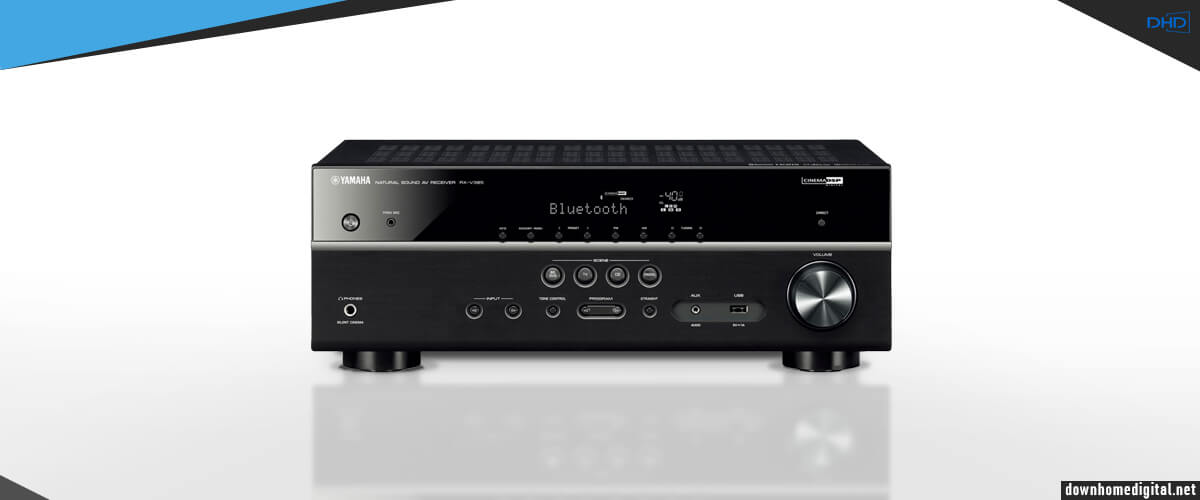
Yamaha occupies one of the first places in the receiver niche, and most of its models are quite popular among both ordinary users and audiophiles. In the budget segment, Yamaha also has several representatives, and RX-V385 is one of them.
The control buttons’ design, size, and appearance have not changed from previous generations of Yamaha RX-series receivers. This should please the supporters of this brand because you won’t have to get used to the new model for a long time. Yamaha RX-V385 belongs to the entry level; that’s why the lower front panel is made of plastic, whereas in higher priced models, it is made of metal.
In general, this is one of the most attractive receivers of my selection, and I liked the button press, which is quite soft and confident and rare for budget devices. Despite being entry-level, this receiver has full screw terminals for connecting speakers. But you should be careful with ventilation because the holes for heat dissipation are located on the top and the left side, and it turned out to be insufficient during a long test (8 hours in a row), and the model overheated.
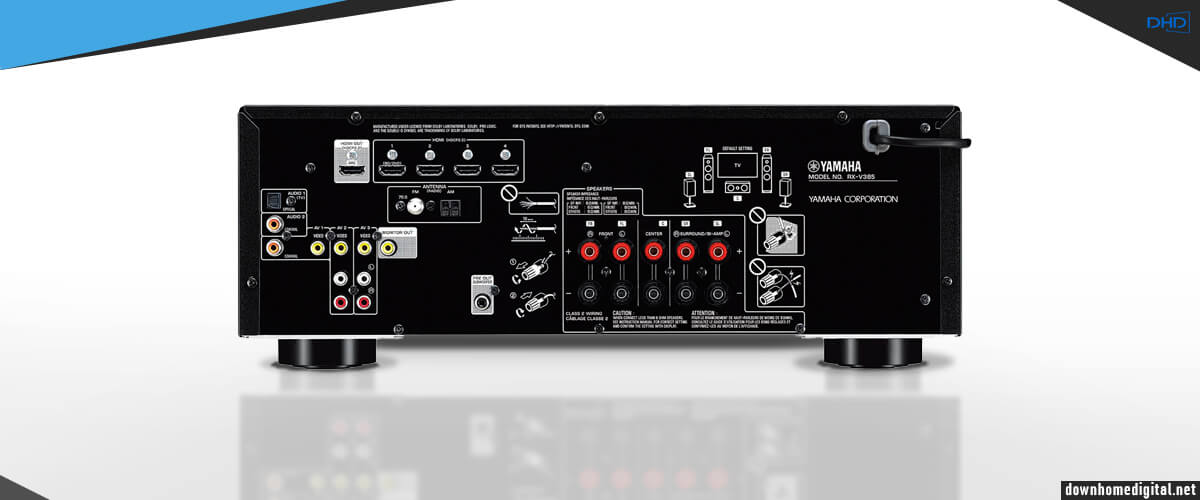
The case itself is made of metal. Ventilation holes for heat dissipation are on the top and the left side. This is something to keep in mind when installing the receiver. This receiver has fully screw terminals to connect the speakers despite the entry-level.
5.1 configuration receiver with 100 watts per channel at 1 kHz – 1 channel 8 ohms, 0.9% THD. It is possible to put speakers with an impedance of 2 ohms on the front channels, but the other channels support a load of 6 ohms or higher. You can also double the front LR speakers in the 2.1 or 3.1 settings.
This model has 4 HDMI inputs and 1 output. This version supports 4K/60p 4:4:4 video and dynamic range – HDR10, Dolby Vision and HLG, colors – BT.2020. The RX-V385 works with Dolby True HD and DTS-HD Master Audio with three BAC-384 kHz/32-bit DACs. It also decodes compressed formats.
Via USB, you can read MP3/WMA/MPEG-4 AAC/WAV, but only up to a resolution of 16 bits/48 kHz. FLAC is not supported in any form. But from my experience, I want to say that listening to music through the USB port of the receiver is not a very interesting thing to do. After all, the RX series is designed more for movies, music concerts, and video clips than for listening to high-quality audio file formats.
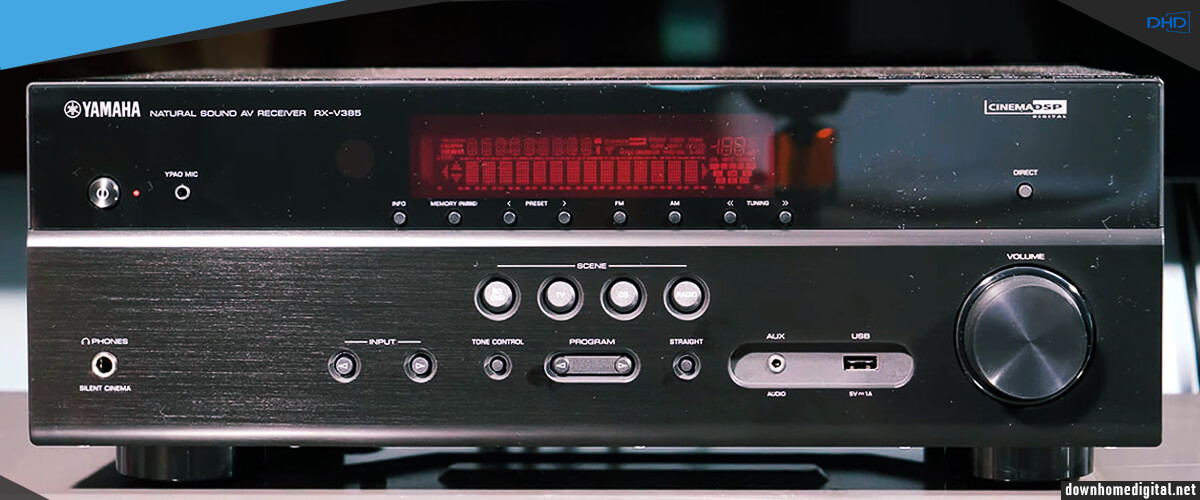
However, I want to note the receiver’s work with a pair of Q Acoustics 3020i shelf speakers. These little guys even externally look great with Yamaha RX-V385 and sound just great (for such an inexpensive system). The sound is clear and coherent, and I even had enough bass, which is extremely surprising for small speakers. No, of course, your floor will not shake from the discharge of lower frequencies, but listening to music, including such compositions as Red Hot Chili Peppers’s Dark Necessities, where the guitar is just great, was extremely comfortable for me (and I am a sophisticated listener).
The only wireless connection here is Bluetooth. Built-in Wi-Fi is already in a different price range.
The remote is very handy, and I like it better than previous generations. It easily controls my media player via HDMI CEC. Important buttons are large, and the rest are well-grouped. The four colored buttons can be assigned different purposes via the menu.
The sound is very large and natural when watching movies and in stereo mode. In addition, a wide stereo panorama is provided by the improved sound return channel.
In my opinion, this is the best AV receiver under $300 because it is user-friendly and delivers surround sound very well if you compare it with other models in the rating (except Sony STR-DH790 and Denon AVR-S670H). You shouldn’t be confused by the lack of Dolby Atmos support since you’re considering a budget receiver. It’s fine. In my rating, only the Sony STR-DH790 handles this surround sound format.
In any case, RX-V385 justifies its money to the fullest extent and even provided that the music with it is not very high quality, you can still watch movies with more pleasure than with a TV set. Moreover, Yamaha is a famous brand; even its simple devices are made with love.
| Power |
|
| HDMI features |
|
| Video features |
|
| Network |
|
| Surround sound processing |
|
Pros
- A well-balanced device for its money.
- ECO mode.
- Dolby and DTS surround sound decoding.
- HD Audio with CINEMA DSP 3D technology.
- YPAO sound optimization system.
- Room optimization microphone, which calibrates the sound for any room.
Cons
- The only receiver with a 5.1 configuration on my list, the very minimum one.
- Lacks Zone 2 capability.
- Overheats over time because the ventilation is not well designed.
Denon AVR-S570BT – also great
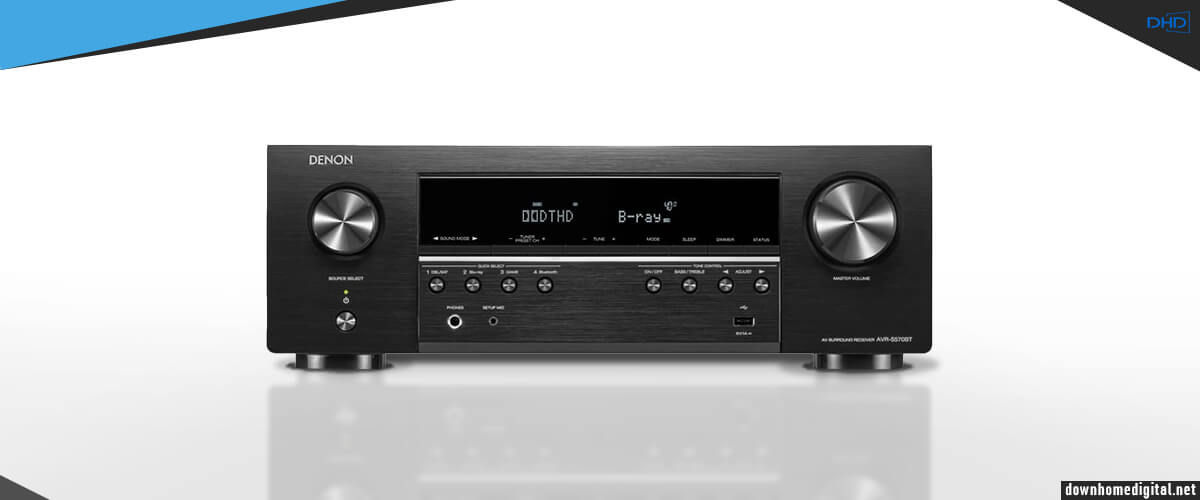
This is another great 5.2-channel AV receiver with many interesting features. It supports Dolby Vision, HDR10, and HLG technologies and allows for 8K upscaling to turn your room into a cinema-like environment, since it’s the first one on the list that offers this authorization. You can take full advantage of 4K/60Hz HDMI inputs with HDCP 2.2 support. After all, the receiver was released in 2022, which significantly affected its functionality.
I have mentioned Denon several times in the comparison features, emphasizing its superiority, but now we will discuss the simpler AVR-S570BT model. Still, even a light touch on the controls and buttons speaks to a quality superior to brands (except Yamaha). I like knowing that even in such a budget device, you can feel the class, although you can’t say it’s on par with more expensive members of its own or other brands. The connectors are mounted securely; I didn’t feel any of them wobbling. The remote is very basic, but you can use the Denon 500 Series Remote app for control and customization, which I liked in this case.
If you like wireless connection methods, the receiver offers Bluetooth features. I tested both wired and wireless connections and have nothing to complain about.

Unlike more advanced receivers, this unit is extremely easy to set up, as there are no confusing settings. I activated the on-screen setup assistant and just followed the guidelines to make the unit work as I needed. What I appreciate is the dedicated equalizer that adjusts the sound based on the parameters of the current environment. So, if you plan to take this receiver from one place to another, it will deliver beautiful sound in every surrounding.
The Denon AVR-S540BT delivers 70 watts when paired with 8-ohm speakers and 90 watts when connected to 6-ohm speakers. When listening to music, I liked that the sound was really powerful and vibrant no matter where I stood. I turned it down and made it louder, but every detail was audible; the sound didn’t blend into a cohesive whole. I love the warm sound of the Denon and have listened to a couple of favorite albums with it on CD and from my smartphone.
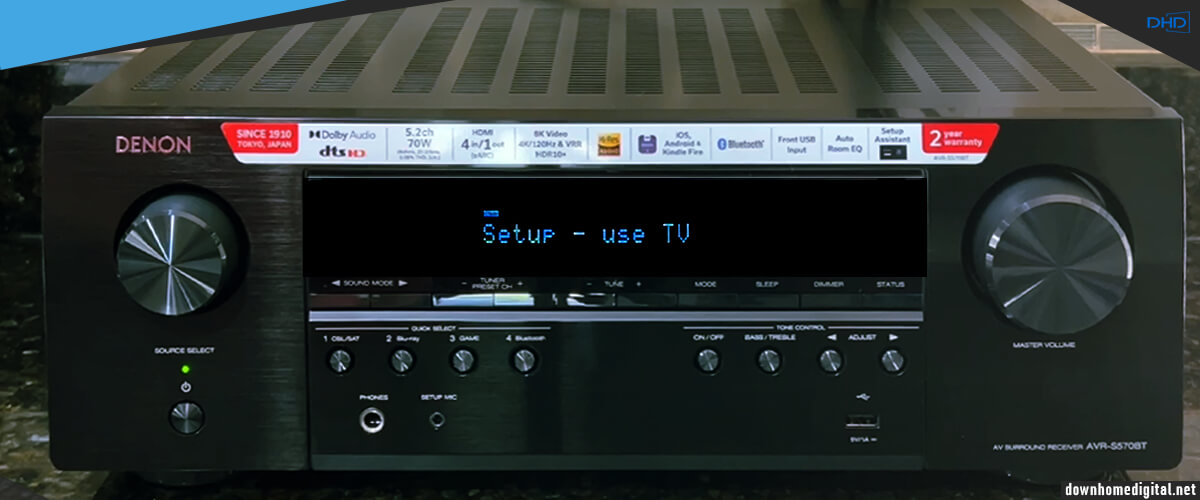
As for the surround sound, I moved around the studio from corner to corner to hear the difference, but in vain. The sound reached every corner well, but I will say right off the bat that we have a 150-square-foot studio room for systems like this. If you have a larger one, I would consider a more powerful receiver, such as the Denon AVR-S660H.
It is unlikely that you will find a better choice for this money. Anyway, except for a few models, all receivers in this category offer 5 channels of amplification, wireless connection as Bluetooth, and not bad video functions. Denon AVR-S570BT can be singled out for 8K video transmission, although upscaling is better not to use, advanced control application, and bright sound. In my opinion, the overall sound picture is inferior to the Sony STR-DH790, as balanced sound in a room of about 150 square feet.
I would recommend it to those who appreciate the warmth of sound more and want to have HDMI ports version 2.1 in the future but still want to keep their budget within the allotted limits. It would be good for first-time users and children/adolescents as a secondary receiver if you have a large house and multiple seating areas. But those who can afford an extra couple hundred dollars should still consider the Denon AVR-S670H.
| Power |
|
| HDMI features |
|
| Video features |
|
| Network |
|
| Surround sound processing |
|
Pros
- All HDMI ports support 8K video.
- Setup is extremely easy.
- The Denon 500 Series Remote app works nicely.
- Sound quality is great at low volume and even when cranking the volume up a notch or two.
- Clear and powerful sound in all corners of a room.
- It shines at switching the UHP signals.
Cons
- The 8K upscaling doesn’t work well.
- The receiver is inferior to the Sony STR-DH790 in the number of channels and balanced sound.
- Remote volume controls leave much to be desired.
- No Wi-Fi.
- You can’t rename assigned inputs.
Sony STR-DH590

The manufacturer claims that by adding Sony STR-DH590 to your home theater system, you will be able to up your media consumption experience and enjoy great sound even in the most distant corners. Is that the truth?
This is the cheapest model of my rating, and it’s designed for the unpretentious user. The case is as plastic as can be, and the receiver overheats a lot, risking melting all those thin panels, so I additionally cooled it all the time I was testing it, and I insist that you do the same if you decide to buy it. It’s also got cute button pops, and the slider scrolls like there’s an endless volume programmed in there. At the same time, the volume itself doesn’t increase too much as you scroll the wheel. It’s hard to call it reliable, but what did you want for the money?

In general, this 5.2-channel AV receiver offers 4K HDR pass-through, Custom Surround Sound, and Dolby Vision, so the picture quality is pretty good. Thanks to Bluetooth and various inputs, I managed to build a robust system using a CD player/Blu-ray player and different speakers. Both wired and wireless connections work normally.
While watching the movie, I was quite satisfied by High Dynamic Range (HDR). Images were sharper, more vibrant, with detailed dark and light areas. This model supports the latest HDR standards such as HDR 10, HLG (Hybrid Log-Gamma), and Dolby Vision, so it much resembles its older brother (Sony STR-DH790) in this regard. But since the STR-DH590 was released in 2014, all its chips are pretty relative. All its abilities are limited to old TV sets, with which it harmonizes quite decently.

Thanks to the S-Force PRO Front Surround technology, the receiver creates virtual surround sound with just two speakers. My studio isn’t large, but the function worked very well, even in such an environment. Another perk aimed at enhancing sound is Digital Cinematic Auto-Calibration Function (DCAC), which optimizes the sound based on your location in relation to the speakers. All in all, it’s definitely better than a regular TV.
The power output with 6 Ohm speakers is 90 watts per channel. That is enough for creating a medium-sized home-theater system. But what I noticed, and feel I need to warn you about, is that the STR-DH590 has no auto-protect feature and simply shuts off at high volume levels.
Considering the feature set and price, I can safely call the Sony STR-DH590 a worthy 4K AV receiver for the investment. It doesn’t have any outstanding advantages over other models, and its construction is flimsy and unreliable, but considering its price, I’m generally amazed that it works at all.
You have to hand it to Sony because this model has been popular since its release in 2014. No model in my memory has lasted this long on the market without needing to be replaced. And all because it sounds surprisingly good, with no glaring distortion. If you’re an unassuming user and don’t shy away from simple things, this is your surefire choice. After all, for this money, you can replace it for yourself even every month.
| Power |
|
| HDMI features |
|
| Video features |
|
| Network |
|
| Surround sound processing |
|
Pros
- Makes speakers sparkle with clarity and crispness.
- Clear robust highs and potent bass.
- Neat back panel layout makes for a very easy setup.
Cons
- It feels like cheap plastic; the buttons are stubborn.
- The volume control scrolls too easily, and the volume does not increase much.
- Slightly confusing controls & menus.
- Poor ventilation system.
- Has no automatic protection feature and simply shuts off at high volume levels.
Denon AVR-S660H
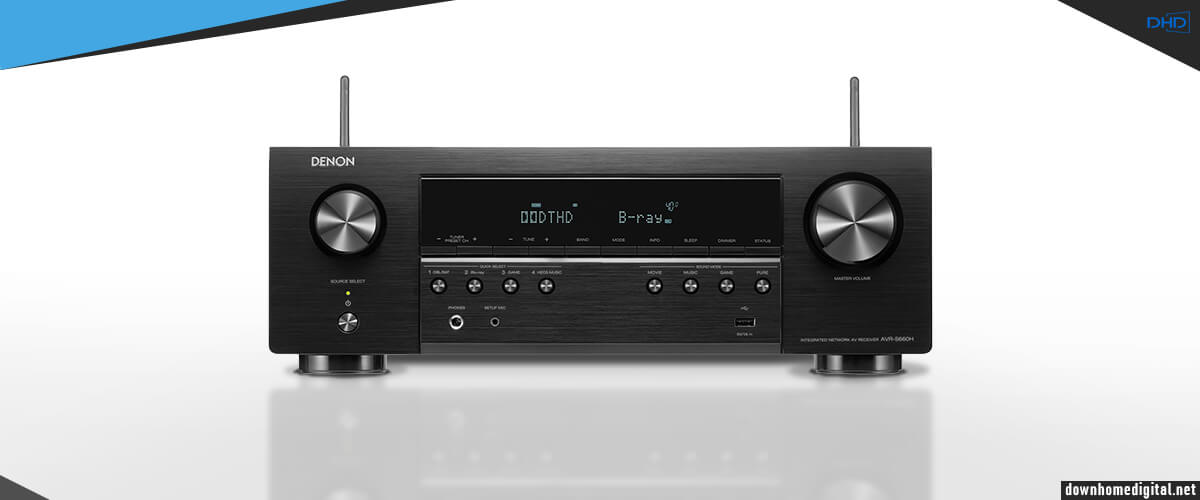
The Denon AVR-S670H is the pride of my selection, despite having only 5 channels of amplification, unlike the 7-channel Sony STR-DH790. The model is representative of the “S” lineup but is endowed with modern “X” series features. When I saw this receiver and familiarized myself with its characteristics, I could not help but subject it to thorough testing. However, since the release was in 2021 and its price is the highest in my selection, I expected a lot from it.
Let me start by saying that an extra hundred bucks means better product quality. You won’t find any external differences between this model and the Denon AVR-S570BT, and I’ve already praised the latter. Yes, the plastic is quite flimsy, but still, we are talking about the category of inexpensive, simple devices, and this compromise is expected. And I can’t note anything significant; all the differences concern the functionality, which the AVR-S670H has wider and better. But you should have expected that it has more connectors for connecting various equipment and more HDMI ports (6/1).
The video technology of this cutie is awesome. The built-in HDMI switch supports modern 8K/3D/HDR10+/HLG/Dolby Vision video formats, and it has CEC for Smart-TV, HDCP 2.3 protection, and eARC. Gamers will love this new product’s responsiveness (it supports ALLM, QFT, and VRR functionality), so it offers more than other receivers in its price range. I also liked the upscaling to 8K. I can’t say it works perfectly, but it’s still more confident, with less lag and pixel hangs, unlike the AVR-S570BT.

The analog interface is represented by two RCA line inputs and a separate jack for connecting a turntable, making it stand out from my selection. Using the available outputs, you can connect two subwoofers and five amplifiers. Each channel (5 in total) can deliver up to 75W (8 ohm, 20 Hz – 20 kHz, 0.08% 2ch). I’m sure that such an indicator of sound clarity can please the most demanding users, and even though at low volume, the receiver sounded very balanced in my studio of large size (up to 300 square feet), reaching every corner with equal quality of detail. However, it does get hot at minimum load and makes strange clicking noises on startup. But this is the “disease” of any equipment made of inexpensive thin plastic; just provide it with decent ventilation.
Regarding support for surround sound technologies, this model is at a higher level than other 5-channel models in the rating. The usual DTS HD Master and Dolby TrueHD formats sound so convincing with whatever speakers I offered the system with the Denon AVR-S670H that I forgot about testing while engrossed in watching movies. I tried Netflix and Blu-ray discs and didn’t notice a single audio moment out of sync with the picture, which is rare for a budget unit. So Dolby Atmos, or rather its absence, is the only area in which the Denon AVR-S670H is inferior to the Sony STR-DH790. On the other hand, the built-in DSP provides a fairly accurate adjustment of the equalizer and filters to adjust the individual acoustics. Well, another positive point is the presence of Audyssey MultiEQ. This auto-calibration system has proven itself over a long time and will really help (especially for beginners) in sound tuning.
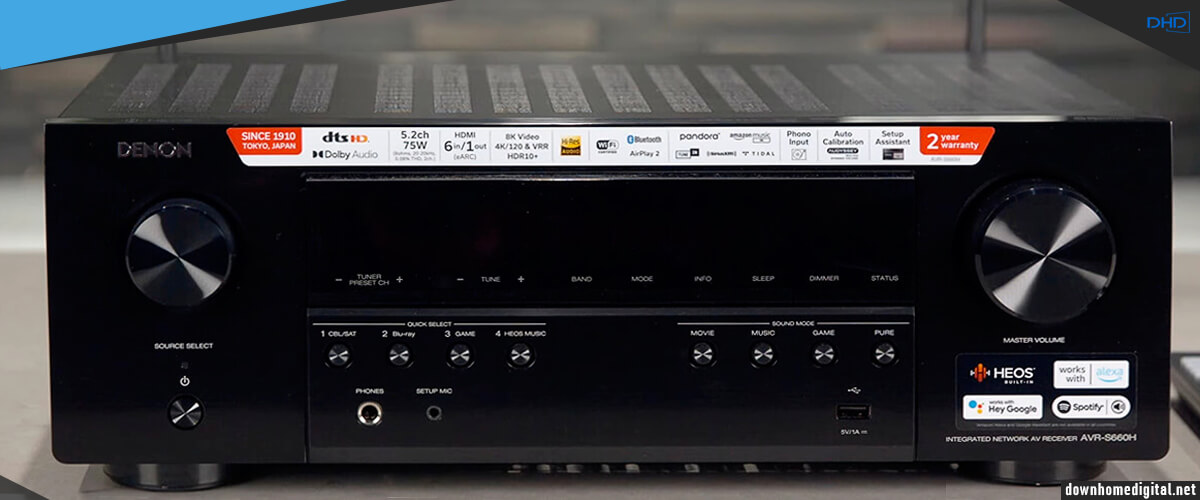
This model – the only one in the rating possesses Wi-Fi, and there is also Bluetooth, Apple AirPlay 2, and multi-room HEOS. So, the ability to play streaming audio can be considered unique within the framework of this review. However, if you cling to it in detail, Bluetooth supports SBC only. There’s no AptX or AAC, which is disappointing considering the modernity of the receiver. It also boasts voice control capabilities (Amazon Alexa, Apple Siri, Google Assistant). The control app, on the other hand, slows down quite a bit, though the idea is great. Hopefully, Denon will soon fix this flaw; it also applies to the brand’s more expensive models.
Denon AVR-S660H is a great 5-channel receiver, which is superior to its rivals in many ways. It supports wireless technology voice assistants, sounds great, and transmits high-quality 8K video. It is not in the first place because it does not have 7 channels of amplification, like the leader of my list, Sony STR-DH790, which means that you will not have access to content with Dolby Atmos. At the same time, the price of AVR-S660H is the highest in the ranking.
Well, I can conclude that I recommend it to those who are after functionality and quality but are not obsessed with modern three-dimensional formats when the sound comes even from the ceiling. What you will choose is up to you, but if I were choosing among 5-channel receivers, I would choose this model, paying a couple hundred bucks extra.
| Power |
|
| HDMI features |
|
| Video features |
|
| Network |
|
| Surround sound processing |
|
Pros
- The power is sufficient for medium-sized rooms, while the THD of 0.08% corresponds to more expensive models.
- The highest number of HDMI ports on the list.
- Video capabilities are wider than other receivers.
- The only receiver in this rating with Wi-Fi.
- Easily plays streaming of numerous music services and Internet radio.
- Phono input for connecting a turntable.
Cons
- The plastic housing is fragile.
- Under minimal load, it heats up and makes strange clicking noises when starting up.
- Bluetooth supports only SBC.
Onkyo TX-SR393
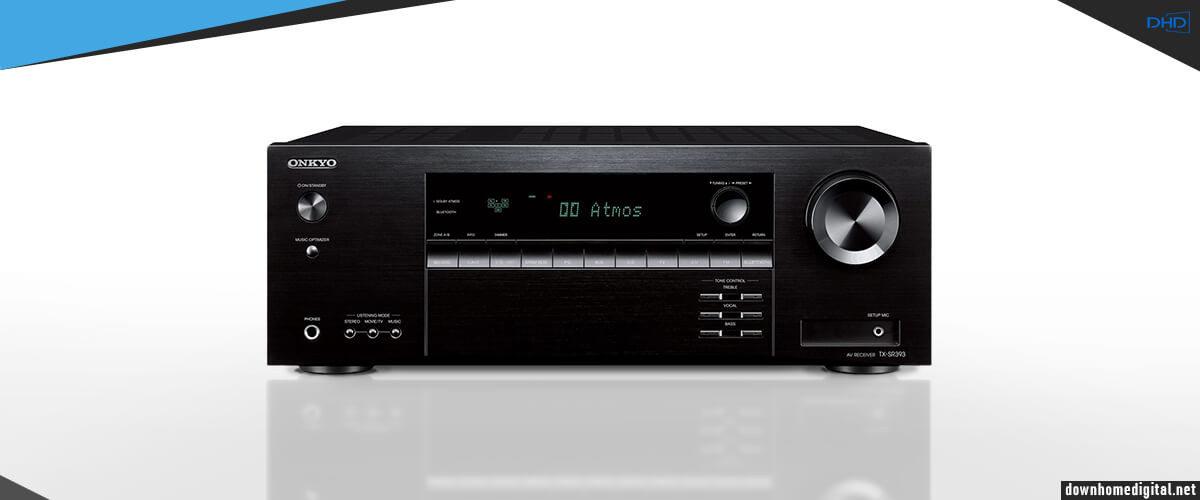
Onkyo TX-SR393 is the successor to the SR-373, so I was curious how the developer has improved the newer version. The first thing that intrigued me is that this model is the most affordable product in its lineup.
I noticed that it has an updated design, and now the device looks more attractive. Another alteration is the set of connectors. Now there is no USB port on the front, as the manufacturer moved it to the rear panel. I don’t think this is a very serious redesign step, but why not. And not for the first time describing this model, I will say that despite the simplicity of the design, I frankly dislike the equalization of frequencies by buttons. Otherwise, the design is thin and unreliable, but it has a rather large LCD, and the controls work confidently.
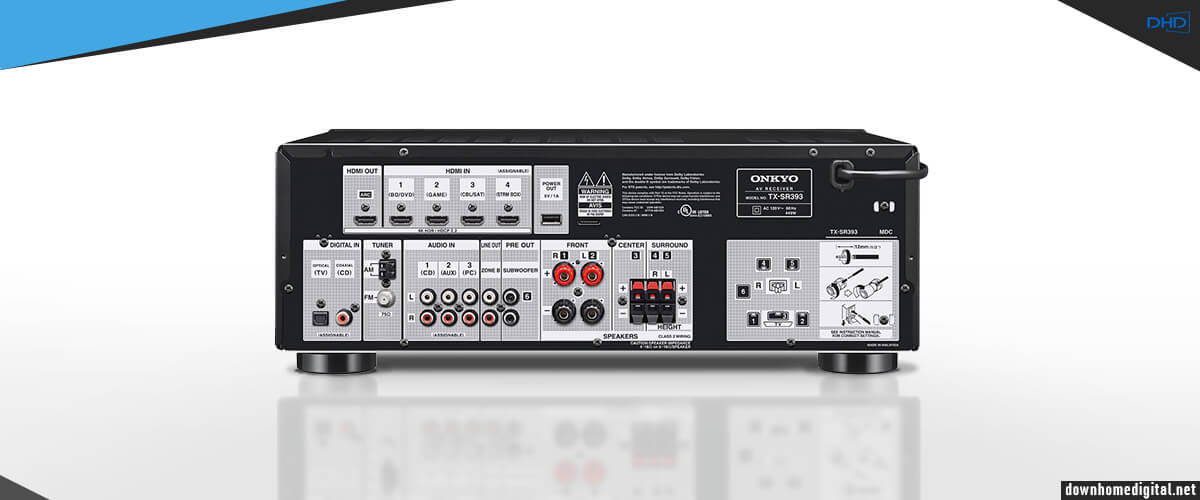
The TX-SR393 is equipped with four HDMI inputs and one output, capable of transmitting 4K UHD signals, including Dolby Vision, HDR10, and HLG. There are no component video inputs and outputs. The device also has three analog and two digital inputs.
The model is equipped with the AccuEQ room calibration function, which is the simplest one available today and is not appreciated by users. But it does the job quite well for a minimal system with non-expressive capabilities. Speaking of pleasant surprises, there are decoders for HD surround sound formats and quality state-of-the-art DACs from Burr-Brown. The output power is 80 watts/8 ohms.
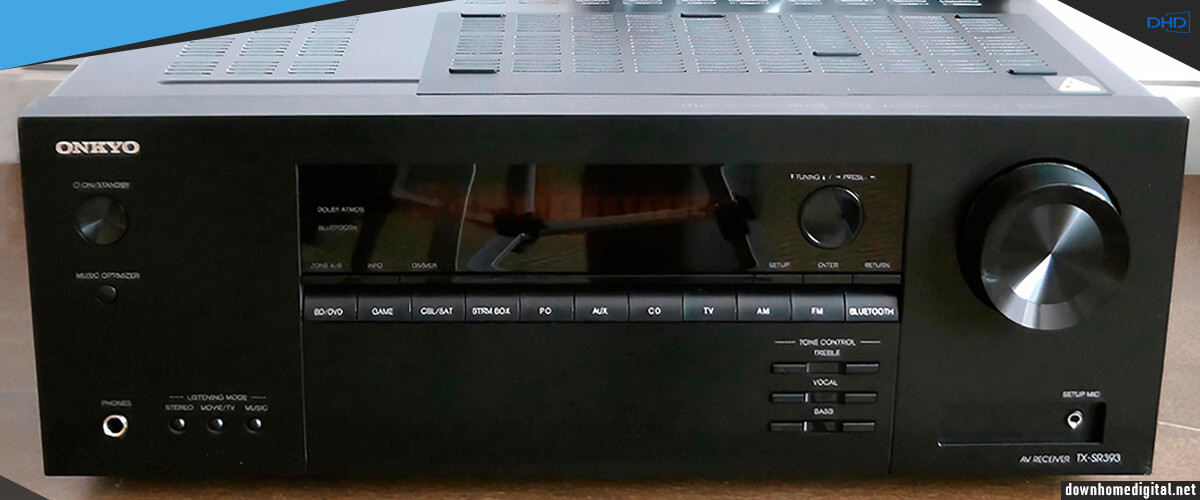
Onkyo TX-SR393 did not appear in the first rows of the rating, as it does not have any expressive sound. Sony STR-DH590 is clearer and chiseled as if every sound is chiseled from stone. The Denon AVR-S570BT produces a warm, realistic sound that suits movies and soft music genres. But Onkyo in their background – is flat, dull, monotonous, without bursts and radiosity. It’s just normal, even sound, more powerful than your TV. As far as I’m concerned, any soundbar would do just as well. If not support for Dolby Atmos and DTS :X surround sound in 3.2.2 configuration. Frankly, I don’t see the point in it, as the sound can’t compare with the 5.2.2 system. It’s like listening to the events of the movie from different places. It’s a strange sensation. I liked the use of Dolby Atmos Height Virtualiser and DTS Virtual:X much better. These technologies create a three-dimensional sound field without using real height speakers while you retain the 5.2 configuration. It sounds very close to real formats, but we’re talking about simulation, and for a minimal system, that’s pretty cool. And this can’t be offered by any of the presented 5-channel receivers in the rating.
If you appreciate music, you’d better look at another receiver. I was no more impressed with the TX-SR393 than with an ordinary boombox of good quality. There is no Wi-Fi as a standard, and the available Bluetooth is no better than that of other models.
To summarize, I can say that the Onkyo TX-SR393 is an entry-level AV receiver that does NOT have outstanding sound compared to the identically priced Sony STR-DH590 and Denon AVR-S570BT. The only thing that separates it from my list of 5-channel receivers is support for Dolby Atmos and DTS:X surround sound formats. The virtual versions of these immersive formats can be considered an outright bonus if you want one of the most inexpensive receivers in the world that gives you simulated upper channels. I understand if this is important to you.
For those who prefer real features, I recommend waiting a couple of months, saving up some money, and buying a Sony STR-DH790 for Dolby Atmos or a Denon AVR-S670H for more functionality.
| Power |
|
| HDMI features |
|
| Video features |
|
| Network |
|
| Surround sound processing |
|
Pros
- There are decoders for HD surround sound formats and high-quality modern DACs from Burr-Brown.
- Dolby Atmos Height Virtualiser and DTS Virtual:X imitate the sound of the upper channels quite well, though they can’t compare with the original.
Cons
- Unreliable case with cheap plastic.
- Frequency equalization is done by buttons.
- Dolby Atmos and DTS:X support in the 3.2.2 configuration does not meet expectations.
- The sound picture is flat and loses to the alternatives, Sony STR-DH590 and Denon AVR-S570BT, in terms of cost and functionality.
Buying guide

Difference between cheap and expensive AV receivers
Trying to find the best budget home theater receiver, you probably want to know what you sacrifice, keeping more advanced options aside. That’s a really serious question, and there is much to think about.
Primarily, you need to understand that low-cost receivers are made of less durable materials if compared to their top-tier counterparts. Though this is a nice move to reduce the price of a unit, does it have any negative consequences? Let’s find out.
The first thing that catches an eye while comparing budgetary and expensive receivers is their design. Starting with a chassis that is more durable in high-priced devices and ending with a fancy styling – the choice is apparent here. Besides, high-end receivers also have a better ventilation system and temperature controls. That is truly important if you plan to use a receiver for many hours in a row.
Another aspect to keep in mind is the number and variety of wired & wireless inputs. No wonder expensive AVRs offer many of these, allowing you to connect all the needed equipment for a pleasurable audio experience. As for the wireless connection, both categories of receivers can be supplied with voice control assistants.
As for an output section, advanced models have separate channel outs for connecting a dedicated power amp, which results in a clearer and more powerful sound. Moreover, they brag about more speaker channel support, which means you will hear fully immersive audio.
I also want to focus on the DSP section, which is responsible for decoding surround sound formats. Though this element is available in both types of receivers, those with a higher price tag are usually capable of decoding more formats.
The quality of the sound you get in your room depends a lot on the calibration mechanism of a receiver. Hi-Fi models are fitted with sophisticated calibration software (Dirac or Audyssey), while some budget-friendly devices may come with less efficient analogs. Besides, manufacturers embed more sound adjustment options in expensive receivers, which entails additional production expenses that are further reflected in the price.
All in all, I won’t make a mistake saying that expensive AV receivers sound better than low-cost analogs. However, it doesn’t mean that budgetary models are absolutely useless. Though they can’t produce as immersive and crisp sound as high-end units, they can easily cater to the needs of average users, who don’t need those powerful basses and encompassing audio.
Do I need a second subwoofer in my home theater system?
There are many receivers designed for 5.1 and 7.1 surround sound setup, but more and more users adapt these models to their needs by complementing them with a second subwoofer. What is the main goal behind such a decision?
Since sound waves don’t move smoothly in a room but bounce off objects and surfaces, you can’t expect to get the same-quality bass across space. This seems frustrating for audiophiles, so they try to even out the “distribution of basses” so that they are equal in every corner.
If you feel like relocating your single woofer to find an ideal spot, you can try to do that, but it is impossible to define it. A more effective way of filling the room with clear bass without peaks and dips is to use the second subwoofer.
When you spend money on a high-quality 5.2 or 7.2 AV receiver, you get a better sound quality with loud basses across the space whether you watch movies, listen to a new album of your favorite band, or play action-packed games.
Do I need Dolby Atmos in a budget receiver?

Dolby Atmos is a surround-sound technology that appeared in the market of audio equipment in 2012. It was primarily used in cinemas but later was adjusted to satisfy home-theater owners. It aims at boosting the capabilities of surround-sound systems by locating surround channels overhead. In other words, in addition to the standard speaker arrangement (along walls), the Dolby Atmos system implies that there are separate speakers that are built into the ceiling, so viewers will be inside a dome of sound.
As for large Dolby Atmos cinemas, the total number of speakers that guarantee immersive sound reaches 400 items. Of course, this is too many for a standard home, but manufacturers offer more space-saving variants for improved audio quality in smaller environments:
- You can upgrade the setup with 2-4 ceiling speakers.
- It is possible to install add-on speaker modules.
- Buy genuine Atmos speakers.
Once you add the Dolby Atmos component to your setup, you will get a precise calibration, so sounds and voices are placed at exact points in the soundfield instead of being scattered across channels. Every speaker in such a system has its peculiar discrete feed, which means you get new front-, surround-, and ceiling-mounted channels.
Some people think that attaching standard speakers to the ceiling will create the same effect as you get with Dolby Atmos technology. But the main thing here is not the location of speakers, but how sound is encoded. With Dolby Atmos, you get the most lifelike sound experience to date.

